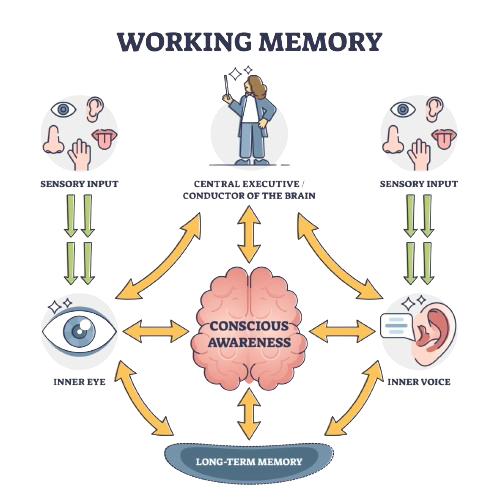Theories
How do students learn?
Memory
The first stop on the memory train for students is their working memory. Working memory, as detailed by Baddley & Hitch, operates in a step by step manner to move sensory input into long-term memory storage (Baddley & Hitch 1974).

As sensory information is provided to students, they must move new material into their long term memory to retain the information. As educators, this is one of our primary goals! This means that we need to transfer new topics from students’ working memory to their long-term memory as effectively as possible. According to Morris et. al, the context in which we provide information can dictate their abilities to retrieve information, thereby effecting their academic performance (Morris et. al 1977).
Retrieval
The method by which a memory is encoded can impact its retrieval. Hence, as educators provide a bridge for new material to be placed into long term memory storage, the method of teaching that education employ is crucial to the retrieval of said information (Hunt 2006).
Engaging Meaningful Learning with Styles
– Can encourage critical thinking, meaningful learning, and conceptual understanding.
– Allows for students to see the content they are being taught, introducing perspective and dimensionality to content.
– If done correctly, can aid students in retrieval due to material’s method of encoding.
– Can decrease meaningful learning and critical thinking.
– Can promotes usage of working memory rather than long-term memory.
– Benefits from usage of strategies such as repetition, flashcards, and mnemonic devices.
Problems with Rote Learning
According to Better Help and many other educational sources, using teaching strategies that promote rote learning are detrimental and solely prioritize repetition over conceptual understanding. However, these teaching styles are still used today. But why? Using styles that promote rote learning in addition to other styles can
- Prevent misconception and confusion on complex topics
- Allow for greater cognitive focus on harder concepts
- Promote practice with arithmetic mastery
Therefore, as we consider the teaching styles that we use, they should be chosen relative to the topic. Providing a proof of the quadratic formula may be harmful early on, but providing conceptual justification for the vertex formula may be beneficial!
– Allows for personal connection to course content, allowing for easier transfer into long-term memory storage.
– Can provide as an outlet for inclusivity and ethics within the classroom when examples are relative to students’ specific circumstances
– Can increase meaningful engagement in the classroom, allowing for a more interactive environment between students.
Problems with Using Real Life Examples
Although using real life examples can be beneficial for connecting students to the material at hand, it can also be problematic.
Consider someone who has never seen or heard of a bullpen being assigned a problem that asks to find the area of one using previous concepts learned in the course. The prior knowledge, or lack thereof, can now interfere with their ability to solve the problem.
How do we address this?
When creating problems which use real life examples, it is crucial to consider the audience. Students who have never seen an icosahedron cannot tell you the shape of its faces, and students who have never done trigonometry will not know what a “radian” is. By writing questions, exams, and homework which are relevant to your particular class, your students will be able to:
- feel represented within the classroom
- decrease cognitive load
- increase understanding of current social issues
Which method is best?
None of them! Research shows that using a combination of these styles will provide a heartier experience for students than exclusively using one method. Likewise, using different amounts of each style relative to each student can increase the performance of students within the classroom (Gentry et al. 1977).



